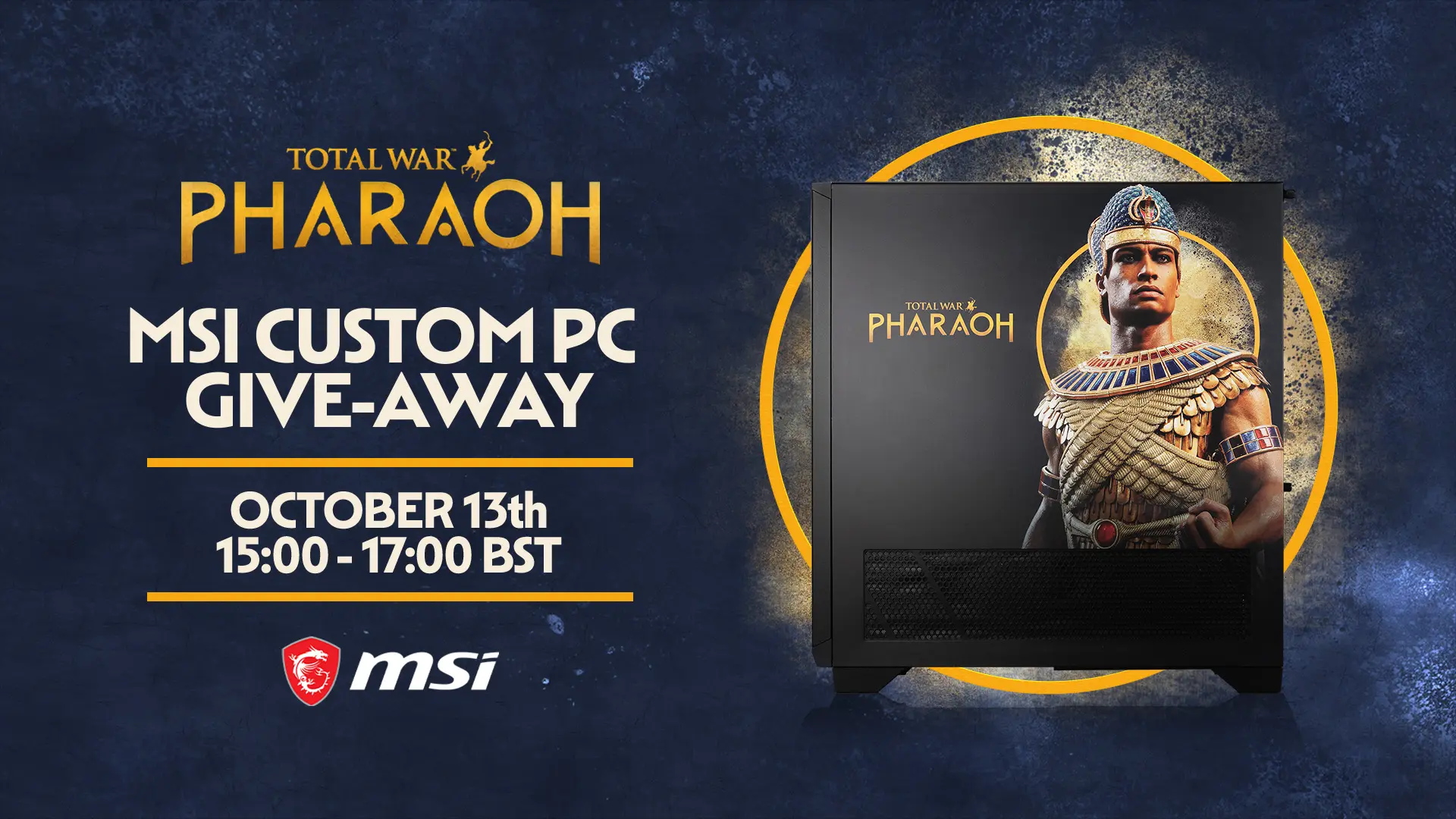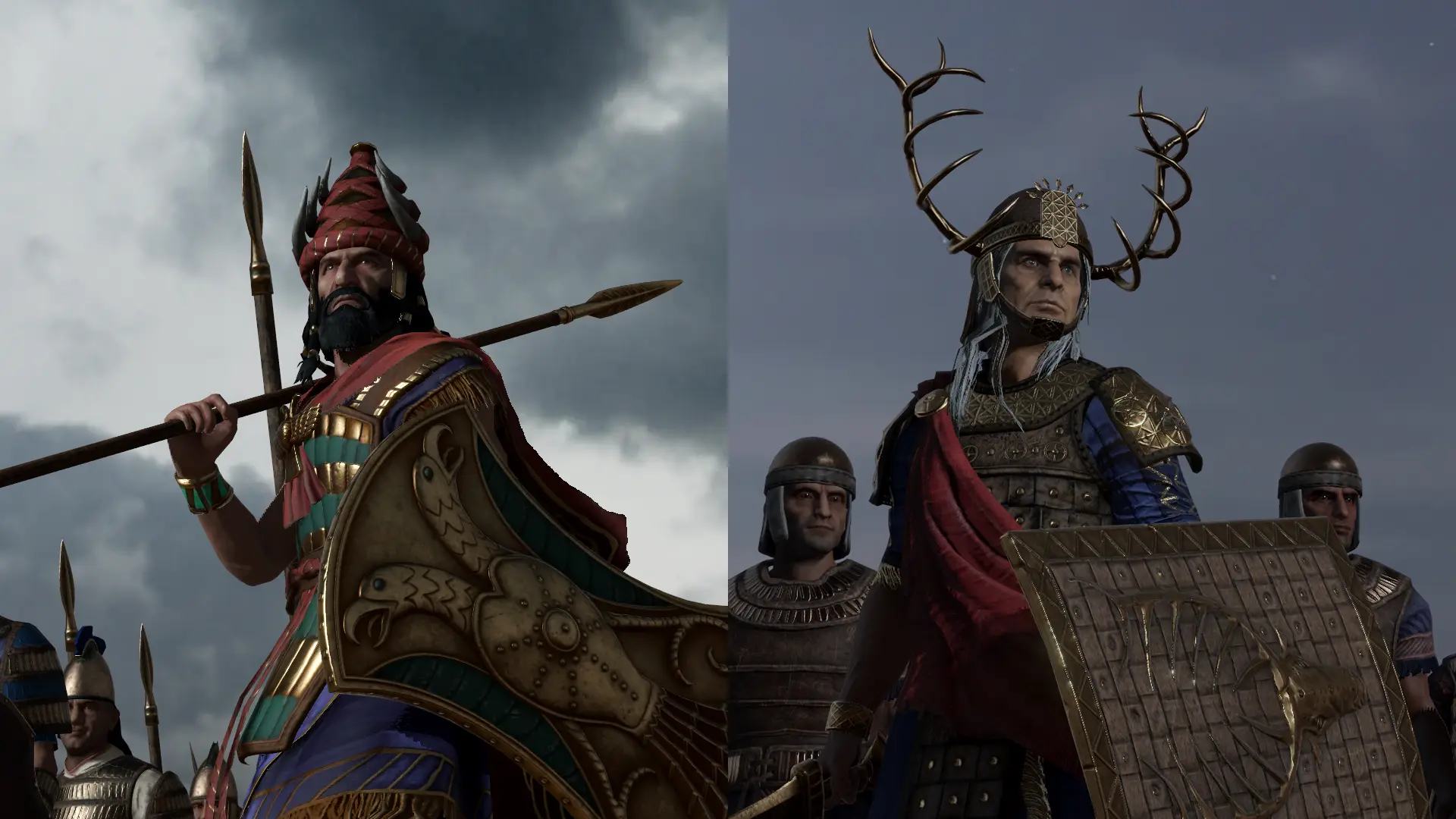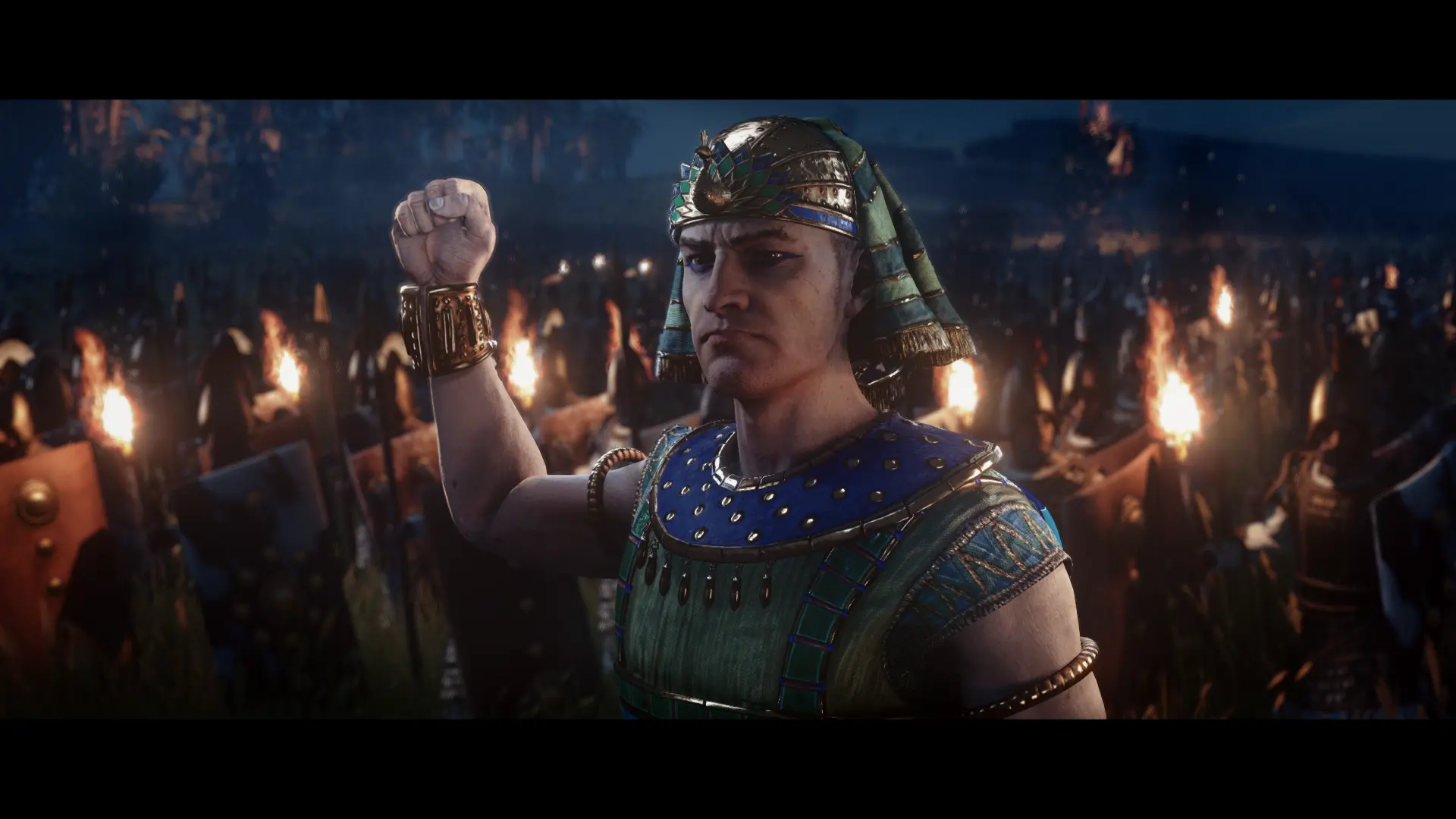
Introducing the Egyptian Factions
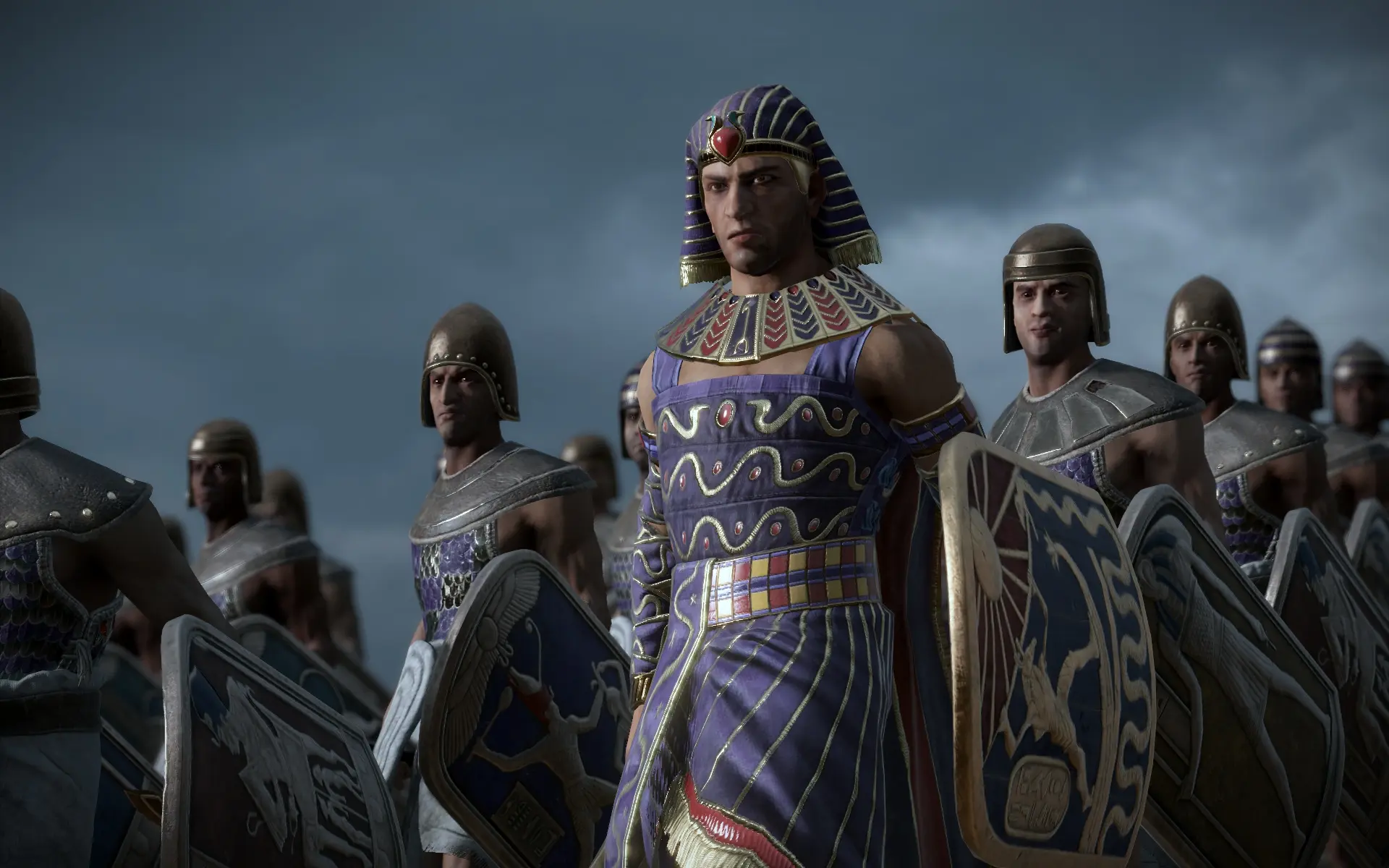
Ramesses, Seti, Tausret and Amenmesse come under the spotlight.

Egypt. The Land of the Pharaohs, one of the greatest civilisations ever known.
The dawn of a new age awaits. Merneptah’s final years are upon us. The hopes of the Egyptian Court, and its people, rest with new leaders – leaders that you will command in Total War: PHARAOH.
Today we examine the game’s Egyptian factions. Guided by your hand, we explore how will they stem the tide of Hittites, Canaanites and the Sea Peoples, and how can they hope to navigate the collapse of the prestigious Bronze Age.

THE EGYPTIAN FACTIONS
On the border of Canaan in Sinai, we have Ramesses.
Begotten of the Sun God, Ra, Ramesses is young, ambitious and ready to follow the path of greatness shared by his namesake, Ramesses II. A martial prodigy, Ramesses’ youth brings speed and capabilities unmatched by his opponents. He’ll need to utilise both to deal with the incursions at the Canaan border from the great raider, Irsu, and the growing menace of darker challenges ahead.
Along the river in Hardai, Seti, the son of Merneptah, skirmishes with the western desert tribes to prove his superiority and worthiness to rule. While birthright sees him next in line to the throne, he yearns to prove his worth in a language more familiar than the parlance of the courts – battle. To him, the Sea Peoples are nothing but a group of barbarous thugs to crush beneath his heel.
Tausret, on the other hand, has a very different approach to power. She cares not for grandstanding and is uninterested in the notion of god given rights – she simply knows she will be a better Pharaoh than anyone else. A methodical genius, Tausret’s strength lies in her intelligence, her planning and her ability to ensure those machinations come to fruition.
Her campaign begins in the deserts of Yebu in Upper Egypt. Through synergising her provinces to bolster her economy and working alongside Seti – or whoever else she can sway to her line of thinking – she strives to maintain the majesty of this ancient empire.
And lastly, down in the South, lies Amenmesse, the Viceroy of Kush. Such a title may sound like a high honour, but to him it’s merely a backhanded compliment – and an unwelcome one at that. While Amenmesse is the eldest male heir, Seti is the designated heir. As grandiose as a title like ‘Viceroy of Kush’ may sound, it’s not nearly as powerful or attractive as ‘Pharaoh’ – a moniker which Amenmesse believes is rightfully his.
Being Viceroy of Kush does offer benefits, however. Benefits like control over Egypt’s gold mines. Amenmesse knows that true power over man isn’t forged in blood but bought with money. He’ll use his wealth to fight his way back up to Mennefer, buying whoever he needs along the way to fulfil his ambitions.

HOW THEY PLAY
With the stage set, let’s explore what makes our cast mechanically distinct from one another. No two journeys to the crown are ever alike.
As a militaristic leader, Ramesses is an exceptionally capable warrior who is efficient with all weapons. His elite warrior status is something also shared by his armies which, while smaller in number, are stronger and more able than the average footsoldier.
Accompanying his impressive martial prowess is incredible speed, both on the field and in the courts, enjoying two court actions per turn compared to the one received by other leaders. His unique buildings also reflect his court standing and status among his people.
‘The Necropolis of the Honoured Dead’ bolsters happiness and influence within provinces, while the ‘Wine Markets’ improve happiness (as one would imagine) and promote workforce growth and resource production. ‘The Military Academy’ produces astounding warriors, raises recruitment rates and reduces the recruitment cost of generals. It also fortifies soldiers with a steady amount of experience.
Seti, meanwhile, is in many ways an opposite to Ramesses. He cares little for the court, preferring to speak in a language he understands fluently: war. With battle always close, Seti focuses on the moment and cares little for the long-term. Thankfully, he begins with Tausret, who understands the courts and diplomacy like the back of her hand.
His starting army is large and his journey commences near all five resource settlement types, allowing him to quickly kickstart his economy… provided he deposes said resources’ current occupiers.
Seti’s unique buildings exemplify his love for war, his sizable ego and his genuine lack of care for the opinions of others. ‘The Mustering Office' increases recruitment slots and decreases the cost of enlisting troops.
The ‘Recruitment Administration Centre’ extends this further while allowing for the training of additional troops. ‘The Tax Administration Palace’, meanwhile, ensures maximum production from the populace – albeit at the cost of workforce growth and happiness.
Lastly, there’s ‘Seti’s Royal Palace’, a glistening monument befitting of a prospective Pharaoh that improves his legitimacy and increases influence. The sight of it boosts his troops’ morale, though opponents dismiss it as unnecessary grandstanding from a potential tyrant. Although we wouldn’t tell him that to his face.
Tausret, meanwhile, understands the importance of structure and resources, especially in trying times such as these. She starts with strong diplomatic ties to her husband Seti, even going as far as being assisted by his forces in some circumstances. Militaristic might isn’t Tausret’s main objective, however – it’s production.
While her unique buildings may not elicit happiness and joy among her people, they are a big boon to their economy. ‘The Provisioning Headquarters’, ‘Tausret’s Armoury’, ‘Tausret’s Goldsmiths’ and the ‘Storage Centre’ all offer powerful buffs that, when executed correctly, offer hugely significant benefits. Build them in provinces with resource generating structures and the buffs will stretch as far as the neighbouring provinces, too.
Her machinations can be perilous, but once Tausret gets the ball rolling, her power and momentum can quickly become hard to stop.
Lastly, we have Amenmesse. As Viceroy of Kush, he begins with significant standing in the Egyptian Courts. This comes with drawbacks, however, as the mixing of Egyptian cultures with the Kushite and the Nubian peoples can create a brittle atmosphere among his closeminded followers that can grow to potentially to problematic levels.
His starting location has plentiful gold within reach for those who can successfully navigate relations with the Kushite people, although one must contend with the natural inclination of Amenmesse’s populous to look down upon foreign institutions. Successfully navigate this tangle, however, and increased production and improved diplomacy await as reward – even if public happiness takes a hit in the process.
This can be somewhat offset with ‘The Hidden Rooms’, which provides big boost to all resources – including happiness and legitimacy to the throne – albeit at vast financial cost. Cost, however, is not of huge concern to Amenmesse, whose ‘Gold Mine Labour Villages’ produce vast wealth, although the great suffering it imparts is problematic… unless you discreetly pay for that problem to quietly go unmentioned, of course.
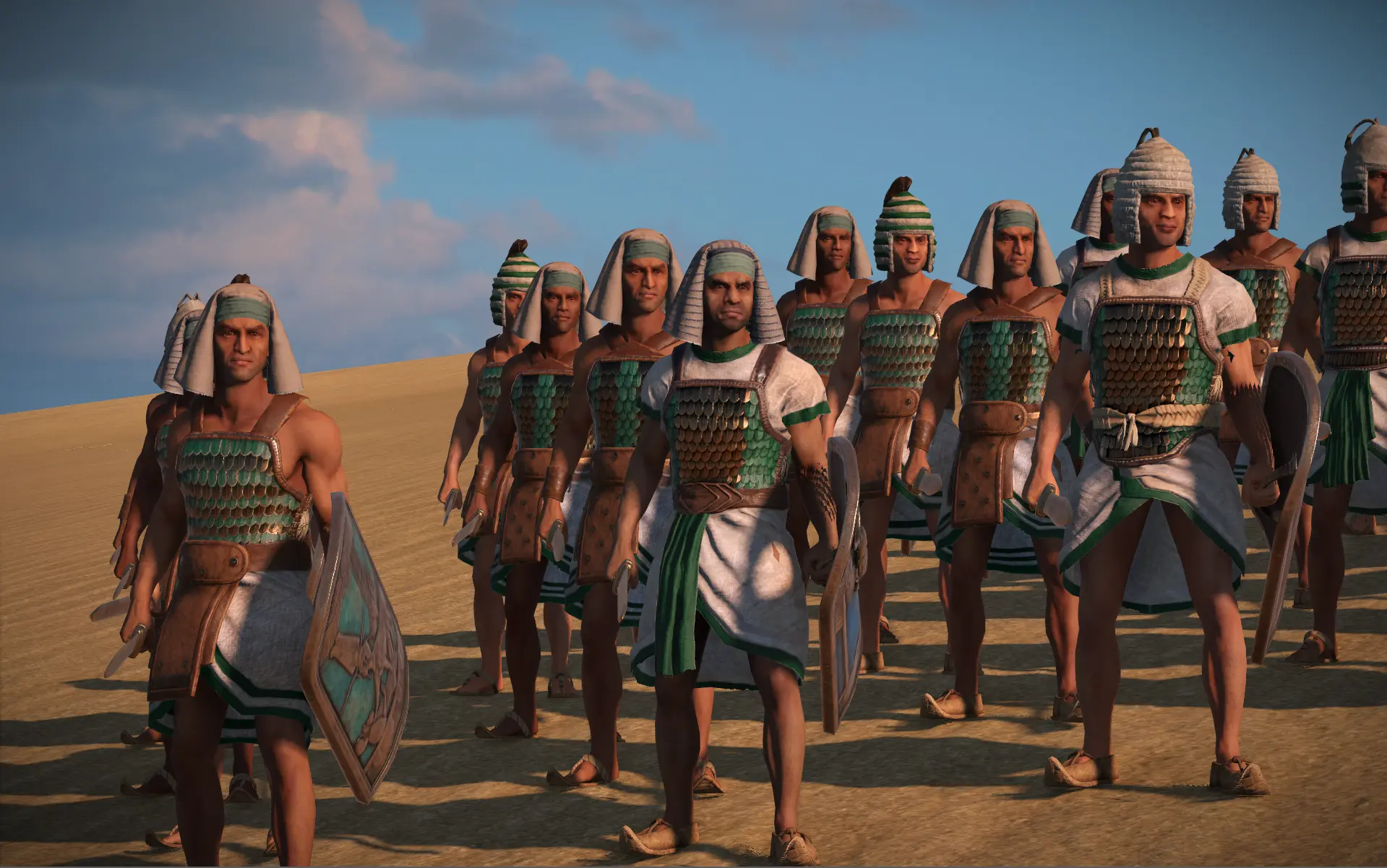
COMPETING ARMIES
The Egyptians are masters of desert warfare and surgical strikes, focusing on primarily lightly armoured forces and a good mixture of ranged and melee units. Strength comes from their speed and manoeuvrability across the land’s vast oceans of sand. Bolstering this with the unique abilities of each region’s natives is vital to success, be that through conquest or diplomacy.
On the border of Canaan you’ll find the Sinai and Retjenu militia. Their forces contain a mixture of expendable units to hold lines or harass, along with high value troops that greater bolster your damage output. Their medium armour units stand toe-to-toe with Canaanite forces thanks to their decent armour piercing and breaking capabilities.
Lower Egypt brings a decent mix of melee and ranged units, although you should expect to pay more than their worth, so try not to rely on this as a primary plan. Not that such armies should not be considered, however, as there is value in their resistance to heat, and their vast number.
In contrast, the forces of Upper Egypt are a potentially very powerful addition to your defensive garrisons. Many of the region’s melee units utilise medium armour, making them an ideal defensive force for guarding any oases found in the vast deserts. As exceptionally capable flankers, they’re able to deal big damage.
In the deserts to the west lie the Libu Tribesmen and the West Desert Natives. The former are unparalleled desert warriors who are unimpeded by loose sand underfoot. Resilient to the sweltering heat of high noon, they can march unharmed through attrition zones in the desert, and the blistering sandstorms that cross the dunes do little to blunt their combat prowess.
To the south you’ll find the Nubian and Kushite forces. These armies are primarily built around the strength of their archers, which are some of the finest in the land, laying siege to opponents who remain preoccupied with numerous expendable harassing units.
Lastly there are the Pharaoh Elite. Available once the crown is yours, these highly disciplined fighters clad in medium armour can turn the tide of battle in your favour, even in very low numbers.

UNIQUE UNITS
Each leader of course also boasts their own unique troops.
Ramesses’ formidable forces reflect his strengths as a leader. The Medjay and Sherden may lack numerically, but can adapt to any situation. Fast and adept at flanking, many of his troops also boast the Underdog trait, allowing them to thrive in fights against multiple units. Potentially outnumbered but rarely outclassed, Ramesses’ retinue are a balanced and highly capable force.
The Levy soldiers that make up Seti’s unique forces, meanwhile, compensate for their lack of skill with enhanced numbers and the Expendable trait, meaning partnering elite troops won’t rout (or potentially even pay the slightest notice) when lower tier units meet their grizzly demise. Many of these elite units, meanwhile, boast the Heedless Charger trait, meaning they dive headlong into battle the moment they spot the enemy and regardless of their orders. Perhaps they believe that such heroism will earn their leader’s respect, or maybe they’re simply emulating an anger he himself all too often elicits…
Tausret’s forces showcase the devastating power of chariots. Their speed and range can cause extreme damage to the enemy, all while staying clear of harm, although her forces enjoy plenty of other resources, too. Tausret’s infantry offerings, such as the steadfast Queen’s Guard, combine excellent defensive capabilities with relentless speed.
When it comes to attacking from distance, however, there are none who can rival the elite archer armies amassed through Amenmesse’s deep pockets. The Kushite, Nubian and Ta-Ceti Archers strike with excellent range and devastating power, and even the lower tiered units in his unique forces can down elite rivals with relative ease.

UNCERTAIN FATES
Dark days approach. With the Bronze Age teetering on the brink of collapse, the fate of Egypt’s people is in your hands. Which leader will you pick and what strategies will you employ as you fight to survive this apocalyptic, historical upheaval?
Are you ready to embrace the mantle of Pharaoh?
